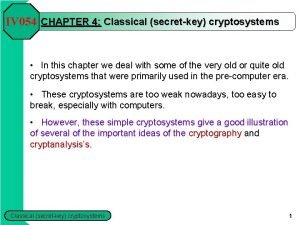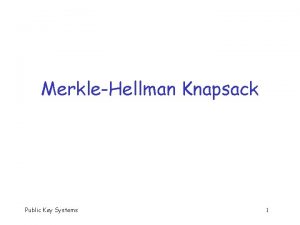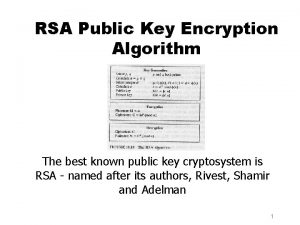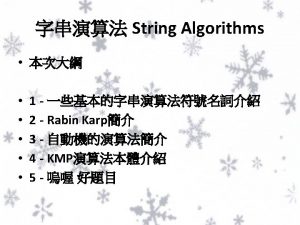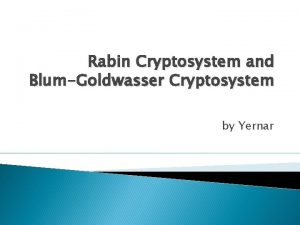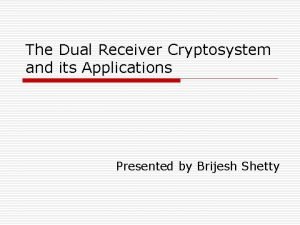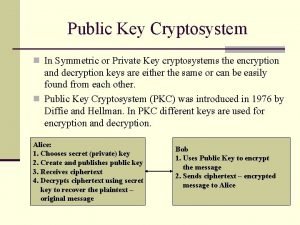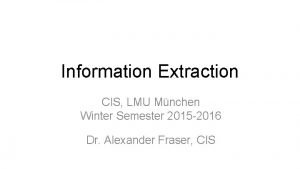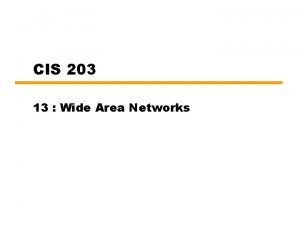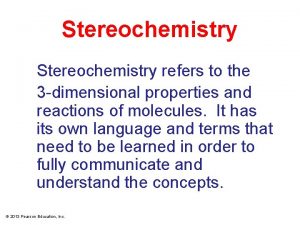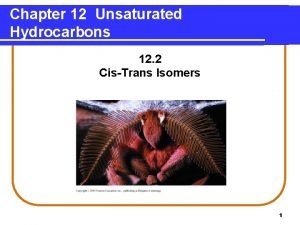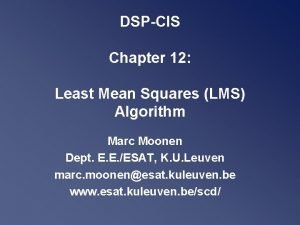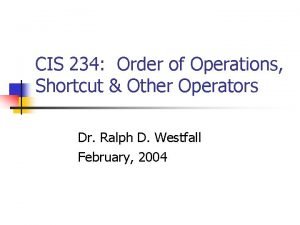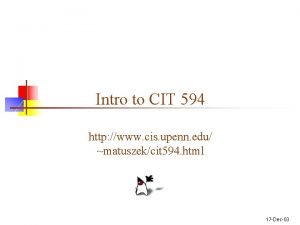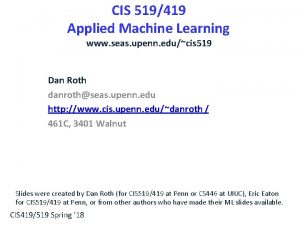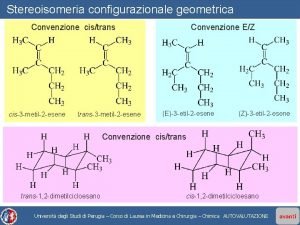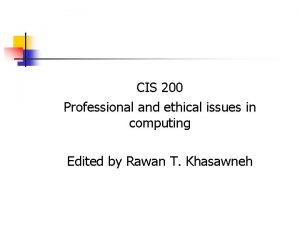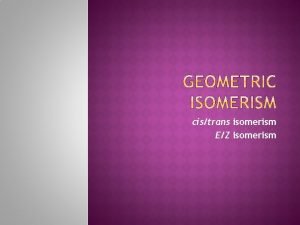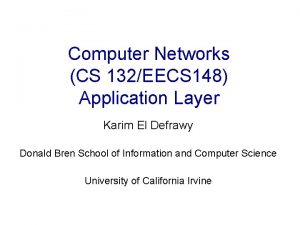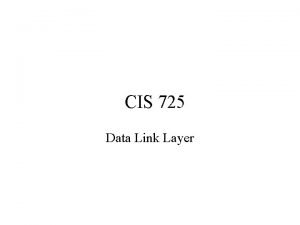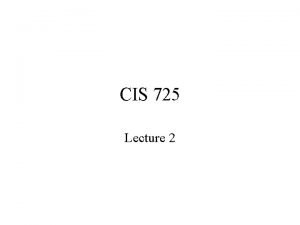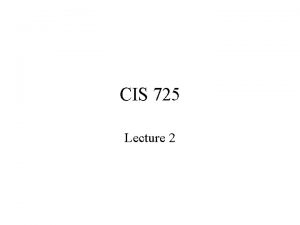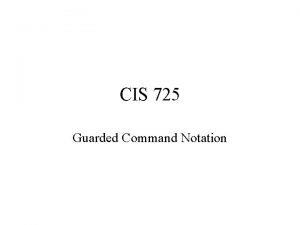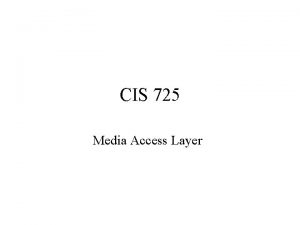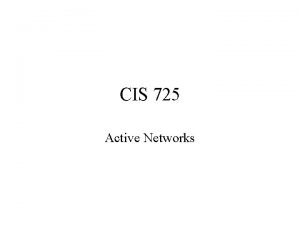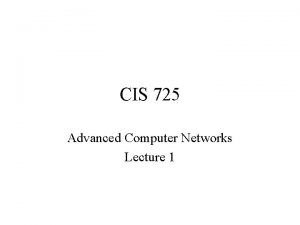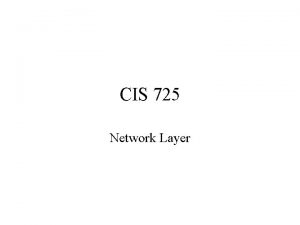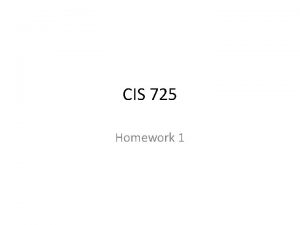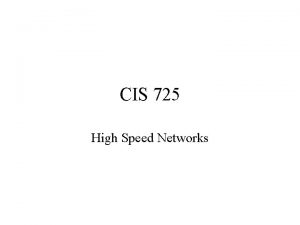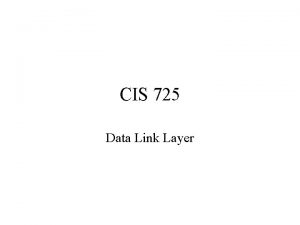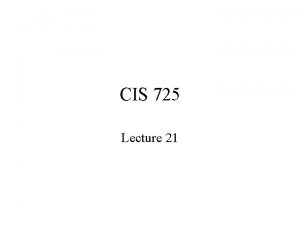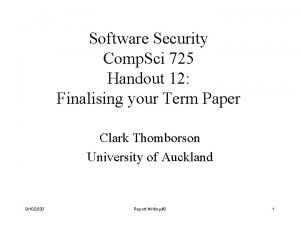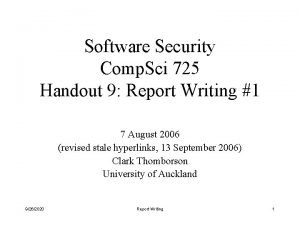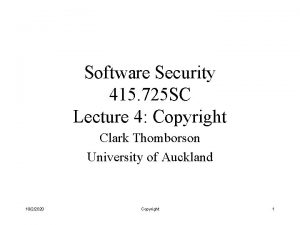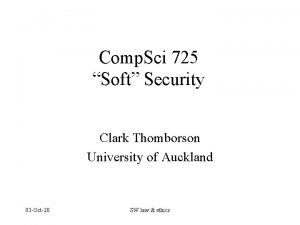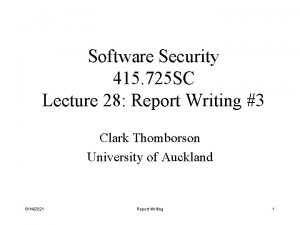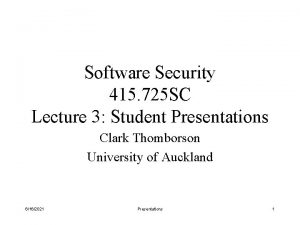CIS 725 Security Cryptosystem Quintuple E D M












































- Slides: 44

CIS 725 Security

Cryptosystem • Quintuple (E, D, M, K, C) • • • M set of plaintexts K set of keys C set of ciphertexts E set of encryption functions e: M K C D set of decryption functions d: C K M plaintext encryption M E ciphertext C decryption D key K listen Passive intruder listen/ alter Active intruder plaintext M

Example • Example: Cæsar cipher – M = { sequences of letters } – K = { i | i is an integer and 0 ≤ i ≤ 25 } – E = { Ek | k K and for all letters m, Ek(m) = (m + k) mod 26 } – D = { Dk | k K and for all letters c, Dk(c) = (26 + c – k) mod 26 } – C=M

Example • k=3 – Plaintext is HELLO WORLD – Change each letter to the third letter following it (X goes to A, Y to B, Z to C) – Ciphertext is KHOOR ZRUOG

Attacks • Opponent whose goal is to break cryptosystem is the adversary – Assume adversary knows algorithm used, but not key • Three types of attacks: – ciphertext only: adversary has only ciphertext; goal is to find plaintext, possibly key – known plaintext: adversary has ciphertext, corresponding plaintext; goal is to find key – chosen plaintext: adversary may supply plaintexts and obtain corresponding ciphertext; goal is to find key

Basis for Attacks • Mathematics and Statistics – Make assumptions about the distribution of letters, pairs of letters (digrams), triplets of letters (trigrams), etc. – Examine ciphertext to correlate it with assumptions

Character Frequencies a 0. 080 h 0. 060 n 0. 070 t 0. 090 b 0. 015 i 0. 065 o 0. 080 u 0. 030 c 0. 030 j 0. 005 p 0. 020 v 0. 010 d 0. 040 k 0. 005 q 0. 002 w 0. 015 e 0. 130 l 0. 035 r 0. 065 x 0. 005 f 0. 020 m 0. 030 s 0. 060 y 0. 020 g 0. 015 z 0. 002

Classical Cryptography • Sender, receiver share common key – Keys may be the same, or trivial to derive from one another – Sometimes called symmetric cryptography • Two basic types – Transposition ciphers – Substitution ciphers – Combinations are called product ciphers

Transposition Cipher • Rearrange letters in plaintext to produce ciphertext. • Letters and length are not changed • Example (Rail-Fence Cipher) – Plaintext is HELLO WORLD – Rearrange as HLOOL ELWRD – Ciphertext is HLOOL ELWRD

Breaking transposition Cipher • Attacker must be aware that it is a transposition cipher • Technique used: Anagramming – Rearranging will not alter the frequency of characters – If 1 -gram frequencies match English frequencies, but other n-gram frequencies do not, probably transposition – Rearrange letters to form n-grams with highest frequencies

Example • Ciphertext: HLOOLELWRD • Frequencies of 2 -grams beginning with H – HE 0. 0305 – HO 0. 0043 – HL, HW, HR, HD < 0. 0010 • Implies E follows H

Example • Arrange so the H and E are adjacent HE LL OW OR LD • Read off across, then down, to get original plaintext

Substitution Ciphers • Each character or a group of characters is replaced by another letter or group of characters. • Example (Cæsar cipher) – Plaintext is HELLO WORLD – Change each letter to the third letter following it (X goes to A, Y to B, Z to C) • Key is 3 – Ciphertext is KHOOR ZRUOG

Breaking Caesar Cipher • Exhaustive search – If the key space is small enough, try all possible keys until you find the right one – Cæsar cipher has 26 possible keys • Statistical analysis – Compare to 1 -gram model of English

Statistical Attack • Compute frequency of each letter in ciphertext: G 0. 1 R 0. 2 H 0. 1 U 0. 1 K 0. 1 Z 0. 1 O 0. 3

Character Frequencies a 0. 080 h 0. 060 n 0. 070 t 0. 090 b 0. 015 i 0. 065 o 0. 080 u 0. 030 c 0. 030 j 0. 005 p 0. 020 v 0. 010 d 0. 040 k 0. 005 q 0. 002 w 0. 015 e 0. 130 l 0. 035 r 0. 065 x 0. 005 f 0. 020 m 0. 030 s 0. 060 y 0. 020 g 0. 015 z 0. 002

Statistical Analysis • f(c) frequency of character c in ciphertext • (i) correlation of frequency of letters in ciphertext with corresponding letters in English, assuming key is i – (i) = 0 ≤ c ≤ 25 f(c)p(c – i) so here, (i) = 0. 1 p(6 – i) + 0. 1 p(7 – i) + 0. 1 p(10 – i) + 0. 3 p(14 – i) + 0. 2 p(17 – i) + 0. 1 p(20 – i) + 0. 1 p(25 – i) • p(x) is frequency of character x in English

Correlation: (i) for 0 ≤ i ≤ 25 i 0 1 2 3 4 5 6 (i) 0. 0482 0. 0364 0. 0410 0. 0575 0. 0252 0. 0190 0. 0660 i 7 8 9 10 11 12 (i) 0. 0442 0. 0202 0. 0267 0. 0635 0. 0262 0. 0325 i 13 14 15 16 17 18 (i) 0. 0520 0. 0535 0. 0226 0. 0322 0. 0392 0. 0299 i 19 20 21 22 23 24 25 (i) 0. 0315 0. 0302 0. 0517 0. 0380 0. 0370 0. 0316 0. 0430

The Result KHOOR ZRUOG • Most probable keys, based on : – i = 6, (i) = 0. 0660 • plaintext EBIIL TLOLA – i = 10, (i) = 0. 0635 • plaintext AXEEH PHKEW – i = 3, (i) = 0. 0575 • plaintext HELLO WORLD – i = 14, (i) = 0. 0535 • plaintext WTAAD LDGAS • Only English phrase is for i = 3 – That’s the key (3 or ‘D’)

Another approach • Guess probable word CTBMN BYCTC BTJDS QXBNS GSTJC BTSWX CTQTZ CQVUJ QJSGS TJQZZ MNQJS VLNSZ VSZJU JDSTS JQUUS JUBXJ DSKSU JSNTK BGAQJ ZBGYQ TCLTZ BNYBN QJSW Probable word is “financial” - Look for repeated letters “i”: 6, 15, 27, 31, 42, 48, 56, 66, 70, 71, 76, 82 - Of these, only 31 and 42 have next letter repeated (“n”) - Only 31 has “a” correctly positioned

Cæsar’s Problem • Key is too short – Can be found by exhaustive search – Statistical frequencies not concealed well • They look too much like regular English letters • So make it longer – Multiple letters in key – Idea is to smooth the statistical frequencies to make cryptanalysis harder

One-Time Pad • A random key at least as long as the message • Convert key to ASCII and compute XOR

Product Cipher: DES • Encrypts blocks of 64 bits using a 64 bit key – outputs 64 bits of ciphertext • A product cipher – basic unit is the bit – performs both substitution and transposition (permutation) on the bits • Cipher consists of 16 rounds (iterations) each with a round key generated from the user-supplied key

Public Key Cryptography • Two keys – Private key known only to individual – Public key available to anyone • Public key, private key inverses

Requirements 1. It must be computationally easy to encipher or decipher a message given the appropriate key 2. It must be computationally infeasible to derive the private key from the public key 3. It must be computationally infeasible to determine the private key from a chosen plaintext attack

RSA • Exponentiation cipher • Relies on the difficulty of determining the number of numbers relatively prime to a large integer n

Background • Totient function (n) – Number of positive integers less than n and relatively prime to n • Relatively prime means with no factors in common with n • Example: (10) = 4 – 1, 3, 7, 9 are relatively prime to 10 • Example: (21) = 12 – 1, 2, 4, 5, 8, 10, 11, 13, 16, 17, 19, 20 are relatively prime to 21

Algorithm • Choose two large prime numbers p, q – Let n = pq; then (n) = (p– 1)(q– 1) – Choose e < n such that e is relatively prime to (n). – Compute d such that ed mod (n) = 1 • Public key: (e, n); private key: (d, n) • Encipher: c = me mod n • Decipher: m = cd mod n

Example • Take p = 7, q = 11, so n = 77 and (n) = 60 • Alice chooses e = 17, making d = 53 • Bob wants to send Alice secret message HELLO (07 04 11 11 14) – – – 0717 mod 77 = 28 0417 mod 77 = 16 1117 mod 77 = 44 1417 mod 77 = 42 • Bob sends 28 16 44 44 42

Example • Alice receives 28 16 44 44 42 • Alice uses private key, d = 53, to decrypt message: – – – 2853 mod 77 = 07 1653 mod 77 = 04 4453 mod 77 = 11 4253 mod 77 = 14 • Alice translates message to letters to read HELLO

Confidentiality Bob PBAlice: M Alice PRAlice - Only Alice can decrypt the message PB: public key PR: private key M

Authentication • Origin authentication • Alice sends a message to Bob • Bob wants to be sure that Alice sent the message

Authentication Alice PRAlice: M PBAlice: M Bob PBAlice M

• Take p = 7, q = 11, so n = 77 and (n) = 60 • Alice chooses e = 17, making d = 53 • Alice wants to send Bob message HELLO (07 04 11 11 14) so Bob knows it is what Alice sent (authenticated) – – – 0753 mod 77 = 35 0453 mod 77 = 09 1153 mod 77 = 44 1453 mod 77 = 49 • Alice sends 35 09 44 44 49

• Bob receives 35 09 44 44 49 • Bob uses Alice’s public key, e = 17, n = 77, to decrypt message: – – – 3517 mod 77 = 07 0917 mod 77 = 04 4417 mod 77 = 11 4917 mod 77 = 14 • Bob translates message to letters to read HELLO – Alice sent it as only she knows her private key, so no one else could have enciphered it – If (enciphered) message’s blocks (letters) altered in transit, would not decrypt properly

• Problems: 1. Rearrange ciphertext but not alter it. For example, “on” can become “no”. 2. Alice’s private key is stolen or she can claim it was stolen 3. Alice can change her private key 4. replay attacks

Integrity: Public key crytography • Bob sends m, Pr. Bob(m) to Alice. • Can Alice use it to prove integrity ?

Integrity: Digital Signatures • Alice wants to send Bob message containing n bits • Bob wants to make sure message has not been altered. • Using a checksum function to generate a set of k bits from a set of n bits (where k ≤ n). • Alice sends both message and checksum • Bob checks whether checksum matches with the message • Example: ASCII parity bit – ASCII has 7 bits; 8 th bit is “parity” – Even parity: even number of 1 bits – Odd parity: odd number of 1 bits 101100111

Hash functions • Using a hash function to generate a set of k bits from a set of n bits (where k ≤ n). • Alice sends both message and hash • Bob checks whether hash matches with the message

Definition • Cryptographic checksum h: A B: – – For any x A, h(x) is easy to compute For any y B, it is computationally infeasible to find x A such that h(x) = y It is computationally infeasible to find two inputs x, x A such that x ≠ x and h(x) = h(x ) –

Integrity Bob Alice M, hash(M) compare M hash

Integrity Pb. A Alice hash(M) M, Pr. A(hash(M)) compare M hash h

Confidentiality, Integrity and Authenication Alice (PBBob(M, PRAlice(hash(M))) PRBob M, PRAlice(hash(M)) PBAlice M, hash(M)

• Problems: 1. Alice’s private key is stolen or she can claim it was stolen 2. Alice can change her private keys
 Doble triple cuadruple ejercicios
Doble triple cuadruple ejercicios 1,151,725 bytes
1,151,725 bytes 454 en yakın yüzlük
454 en yakın yüzlük Provate security
Provate security Cryptosystem
Cryptosystem Knapsack cryptosystem example
Knapsack cryptosystem example Vigenere definition
Vigenere definition This destroys the rsa cryptosystem
This destroys the rsa cryptosystem Rabin-karp 's algorithm
Rabin-karp 's algorithm Explain rabin cryptosystem
Explain rabin cryptosystem Cryptosystem
Cryptosystem Knapsack cryptosystem
Knapsack cryptosystem Security guide to network security fundamentals
Security guide to network security fundamentals Guide to network security
Guide to network security E commerce security policy
E commerce security policy Visa international security model
Visa international security model Wireless security in cryptography and network security
Wireless security in cryptography and network security Building security software
Building security software Electronic mail security in network security
Electronic mail security in network security Security guide to network security fundamentals
Security guide to network security fundamentals Osi architecture in network security
Osi architecture in network security Cnss model 27 cells example
Cnss model 27 cells example Cis hill
Cis hill Oksalosirćetna kiselina
Oksalosirćetna kiselina Cis lmu
Cis lmu Cis 4004
Cis 4004 Cis clervaux
Cis clervaux Cis
Cis Properties of diastereomers
Properties of diastereomers Cis trans isomers
Cis trans isomers Nada enharmonis adalah
Nada enharmonis adalah Mean ?
Mean ? Cis tcp fin services
Cis tcp fin services Cis shortcut
Cis shortcut Cis90
Cis90 Penn cit
Penn cit Reddit
Reddit Cis 419 upenn
Cis 419 upenn Cis 4004
Cis 4004 Trans-2-esene
Trans-2-esene Cis200
Cis200 E/z isomers
E/z isomers Telnet cis.poly.edu 80
Telnet cis.poly.edu 80 Cis trans izomeri nedir
Cis trans izomeri nedir Cis moss
Cis moss




